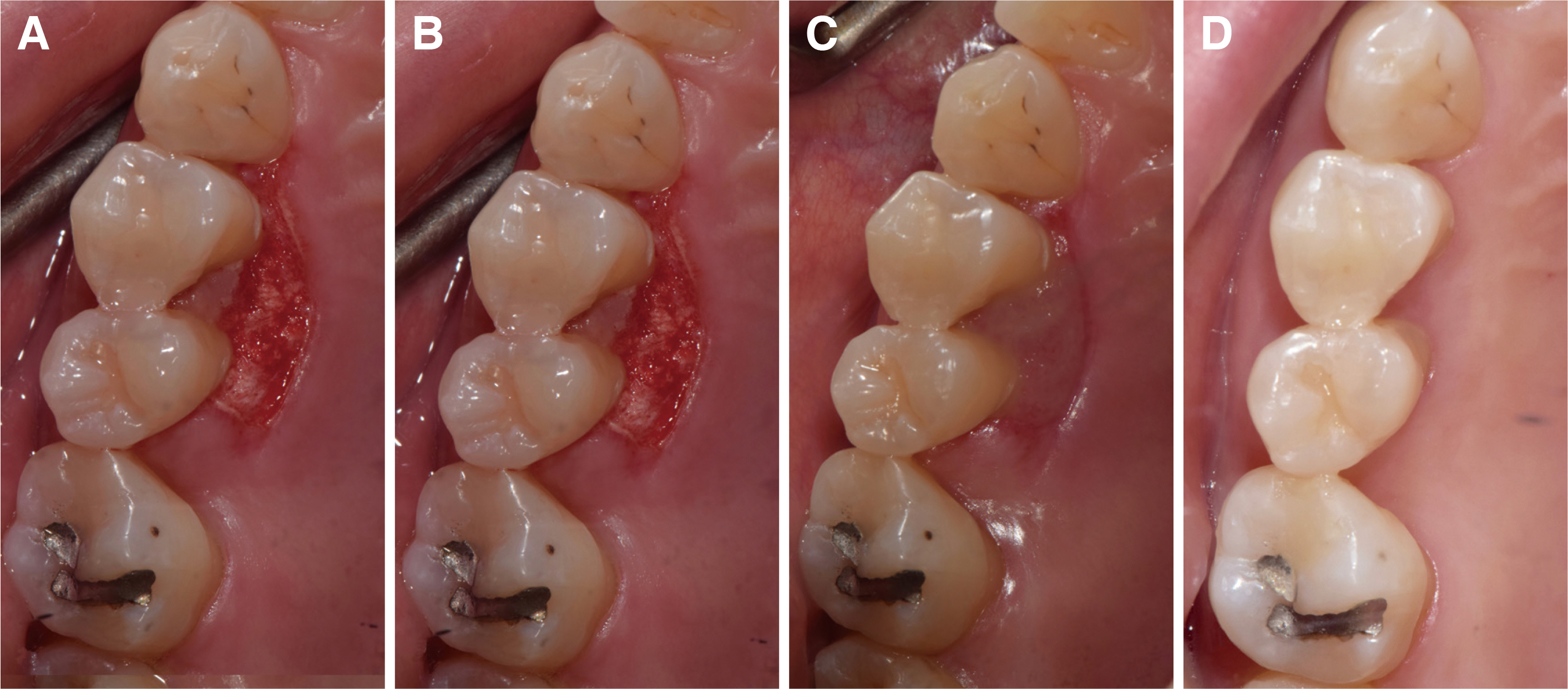J Dent Rehabil Appl Sci.
2021 Dec;37(4):294-300. 10.14368/jdras.2021.37.4.294.
The clinical and microbiological effects of non-surgical periodontal treatments in necrotizing periodontal disease: case report
- Affiliations
-
- 1Department of Periodontology, College of Dentistry, Dankook University, Cheonan, Republic of Korea
- 2Department of Periodontology, Dankook University Dental Hospital, Cheonan, Republic of Korea
- KMID: 2526005
- DOI: http://doi.org/10.14368/jdras.2021.37.4.294
Abstract
- Necrotizing periodontal disease caused by plaque bacteria is showed clinical findings including pseudo-membrane, interproximal necrosis of the affected area, pain on palpation and gingiva bleeding. Microbiological examination is showed that patients have fusospirochetal bacteria. Two patients who were provisionally diagnosed as necrotizing periodontal disease received nonsurgical periodontal treatments in conjunction with dressing using 3% hydrogen peroxide and local antibiotic delivery. Before and 3 - 5 days after initial treatment, the levels of periodontal bacteria in gingival crevicular fluid obtained using quantitative PCR were compared. After treatment, patients recovered normal gingiva. The number of periodontal diseases related bacterial species decreased from seven or eight to one. As a result, periodontium of patients with necrotizing periodontal disease was recovered to normal periodontium by nonsurgical periodontal treatments.
Figure
Reference
-
References
1. Park JB. 1983; Symptoms & treatment of ulcerative conditions. J Korean Dent Assoc. 21:449–52.2. Horning GM, Cohen ME. 1995; Necrotizing ulcerative gingivitis, periodontitis and stomatitis: Clinical staging and predisposing factors. J Periodontol. 66:990–8. DOI: 10.1902/jop.1995.66.11.990. PMID: 8558402.3. Herrera D, Retamal-Valdes B, Alonso B, Feres M. 2018; Acute periodontal lesions (periodontal abscesses and necrotizing periodontal diseases) and endoperiodontal lesions. J Clin Periodontol. 45:S78–S94. DOI: 10.1111/jcpe.12941. PMID: 29926493.4. Newman MG, Takei H, Klokkevold PR, Carranza FA. 2011. Carranza's clinical periodontology. 12th ed. Elsevier health sciences;Amsterdam: p. 271–9. p. 350–3.5. Rosebury T. Gordon SM, editor. 1938. The etiology of Vincent's infection. Dental science and dental art. Lea & Febiger;Philadelphia: p. 415.6. Loesche WJ, Syed SA, Laughon BE, Stoll J. 1982; The bacteriology of acute necrotizing ulcerative gingivitis. J Periodontol. 53:223–30. DOI: 10.1902/jop.1982.53.4.223. PMID: 6122728.7. Lang NP, Berglundh T, Giannobile WV, Sanz M. 2021. Lindhe's clinical periodontology and implant dentistry. 6th ed. John Wiley & Sons;Hoboken: p. 428–33.8. Gomes EWB, Casarin M, Martins TM, da Silva AF. 2020; Local delivery therapies as adjuvants to non-surgical periodontal treatment of periodontitis grade C: a systematic review. Clin Oral Investig. 24:4213–24. DOI: 10.1007/s00784-020-03631-8. PMID: 33070281.9. Nakagawa T, Yamada S, Oosuka Y, Saito A, Hosaka Y, Ishikawa T, Okuda K. 1991; Clinical and microbiological study of local minocycline delivery (Periocline) following scaling and root planing in recurrent periodontal pockets. Bull Tokyo Dent Coll. 32:63–70. PMID: 1819445.10. Pfaffl MW. 2001; A new mathematical model for relative quantification in real-time RT-PCR. Nucleic Acids Res. 29:e45. DOI: 10.1093/nar/29.9.e45. PMID: 11328886. PMCID: PMC55695.11. Haffajee AD, Socransky SS, Patel MR, Song X. 2008; Microbial complexes in supragingival plaque. Oral Microbiol Immunol. 23:196–205. DOI: 10.1111/j.1399-302X.2007.00411.x. PMID: 18402605.12. Malek R, Gharibi A, Khlil N, Kissa J. 2017; Necrotizing ulcerative gingivitis. Contemp Clin Dent. 8:496–500. DOI: 10.4103/ccd.ccd_1181_16. PMID: 29042743. PMCID: PMC5644015.13. Klotz H. 1973; Differentiation between necrotic ulcerative gingivitis and primary herpetic gingivostomatitis. N Y State Dent J. 39:283–94. PMID: 4348461.14. Novak MJ. 1999; Necrotizing ulcerative periodontitis. Ann Periodontol. 4:74–8. DOI: 10.1902/annals.1999.4.1.74. PMID: 10863377.15. Formicola AJ, Witte ET, Curran PM. 1970; A study of personality traits and acute necrotizing ulcerative gingivitis. J Periodontol. 41:36–8. DOI: 10.1902/jop.1970.41.41.36. PMID: 5264373.16. O'Connor BC, Newman HN, Wilson M. 1990; Susceptibility and resistance of plaque bacteria to minocycline. J Periodontol. 61:228–33. DOI: 10.1902/jop.1990.61.4.228. PMID: 2324922.17. Wennström J, Lindhe J. 1979; Effect of hydrogen peroxide on developing plaque and gingivitis in man. J Clin Periodontol. 6:115–30. DOI: 10.1111/j.1600-051X.1979.tb02190.x. PMID: 379049.
- Full Text Links
- Actions
-
Cited
- CITED
-
- Close
- Share
- Similar articles
-
- Periodontitis and Periodontal treatment of Hansen's Patients in National Sorokdo Hospital (Case Report)
- Waiting for innovations in periodontal disease diagnosis
- Reply on "Relationship between maternal periodontal disease and Apgar score of newborns"
- Clinical and microbiological effects of the supplementary use of an erythritol powder air-polishing device in non-surgical periodontal therapy: a randomized clinical trial
- An analytical on the periodontal conditions and treatment in leprous patients



